 Flowering maples are a group of tender, evergreen perennials often used as seasonal annuals or houseplants in the Midwest. Sometimes also collectively referred to as Chinese bellflower or Chinese lantern – or just abutilon, flowering maples were popular during the Victorian era, later fell out of favor in the gardening world, but have returned to modern gardens in a plethora of forms.
Flowering maples are a group of tender, evergreen perennials often used as seasonal annuals or houseplants in the Midwest. Sometimes also collectively referred to as Chinese bellflower or Chinese lantern – or just abutilon, flowering maples were popular during the Victorian era, later fell out of favor in the gardening world, but have returned to modern gardens in a plethora of forms. 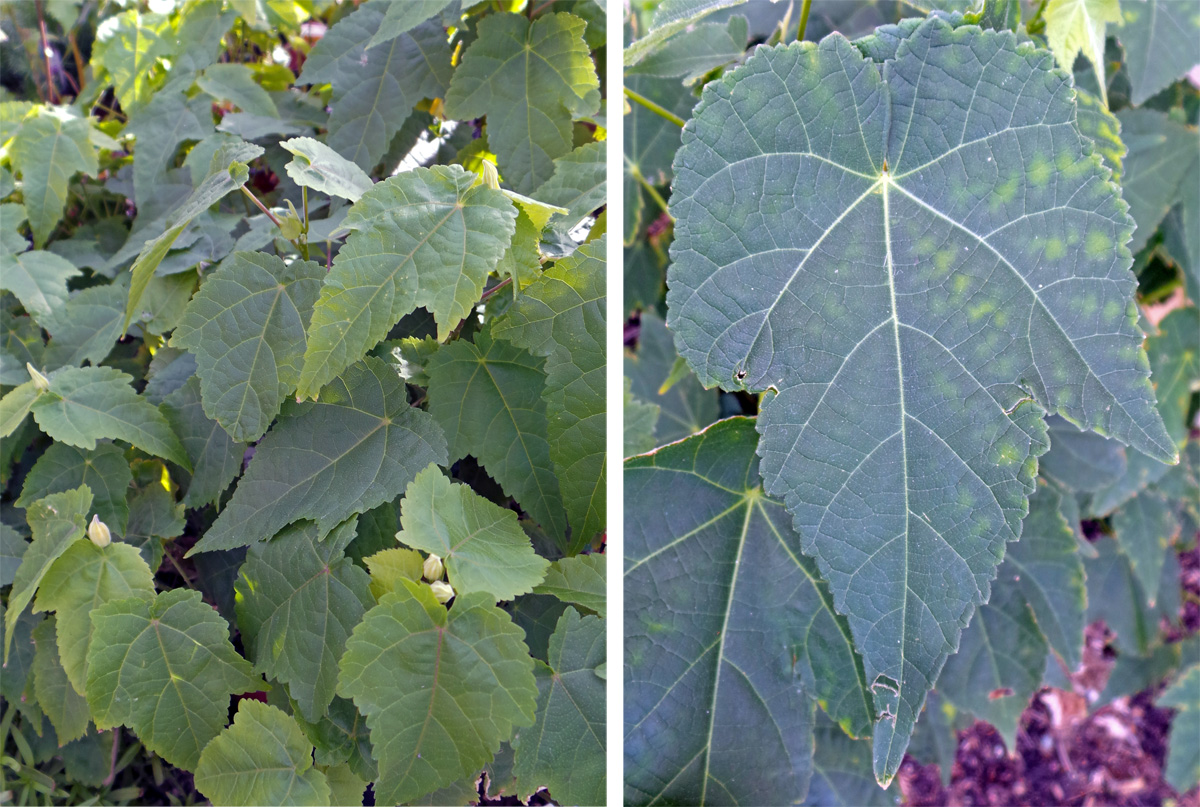 The genus Abutilon is a large group of flowering plants in the mallow family (Malvaceae) with over 200 species occurring throughout the tropics and subtropics. They range in height from 18 inches to 10 feet, and may be herbaceous perennials, shrubs, or small trees. The plants used as ornamentals are often A. x hybridum, a group of hybrids between A. darwinii and A. striatum, or cultivars of other species, such as A. megapotamicum and A. pictum. These plants get part of their common name from the resemblance of the foliage to maple leaves. The plants are unrelated to maples (Acer spp.) but do have palmate leaves often with deep, pointed lobes and/or serrated edges. The leaves may cause mild dermatitis in susceptible individuals.
The genus Abutilon is a large group of flowering plants in the mallow family (Malvaceae) with over 200 species occurring throughout the tropics and subtropics. They range in height from 18 inches to 10 feet, and may be herbaceous perennials, shrubs, or small trees. The plants used as ornamentals are often A. x hybridum, a group of hybrids between A. darwinii and A. striatum, or cultivars of other species, such as A. megapotamicum and A. pictum. These plants get part of their common name from the resemblance of the foliage to maple leaves. The plants are unrelated to maples (Acer spp.) but do have palmate leaves often with deep, pointed lobes and/or serrated edges. The leaves may cause mild dermatitis in susceptible individuals. 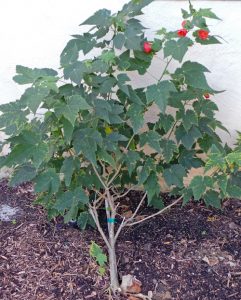 They are upright, branching plants—often with brittle stems—and some varieties have a structure reminiscent of a Japanese maple. They are low growing woody subshrubs that acts as herbaceous perennials in colder climates, supposedly hardy only in zones 9-11, but will survive in some colder areas as long as the plants have excellent soil drainage. The generally solitary pendent flowers are borne on long pedicels from leaf axils or near the branch tips on the current season’s growth. The lantern-like buds open to cup- or bell-shaped flowers up to 3 inches in diameter.
They are upright, branching plants—often with brittle stems—and some varieties have a structure reminiscent of a Japanese maple. They are low growing woody subshrubs that acts as herbaceous perennials in colder climates, supposedly hardy only in zones 9-11, but will survive in some colder areas as long as the plants have excellent soil drainage. The generally solitary pendent flowers are borne on long pedicels from leaf axils or near the branch tips on the current season’s growth. The lantern-like buds open to cup- or bell-shaped flowers up to 3 inches in diameter.  All have a calyx and corolla with 5 parts, with overlapping papery petals fused at the base, opening to various degrees from trumpet shaped to nearly flat. The flowers have staminal columns typical of the mallow family, with multiple stamens fused into a column lined with anthers, and a branched style with head-like stigmas inside the tube (very similar to that of its relative the hibiscus). The species generally have yellow or orange flowers, but others have red or pink petals with a darker center.
All have a calyx and corolla with 5 parts, with overlapping papery petals fused at the base, opening to various degrees from trumpet shaped to nearly flat. The flowers have staminal columns typical of the mallow family, with multiple stamens fused into a column lined with anthers, and a branched style with head-like stigmas inside the tube (very similar to that of its relative the hibiscus). The species generally have yellow or orange flowers, but others have red or pink petals with a darker center. 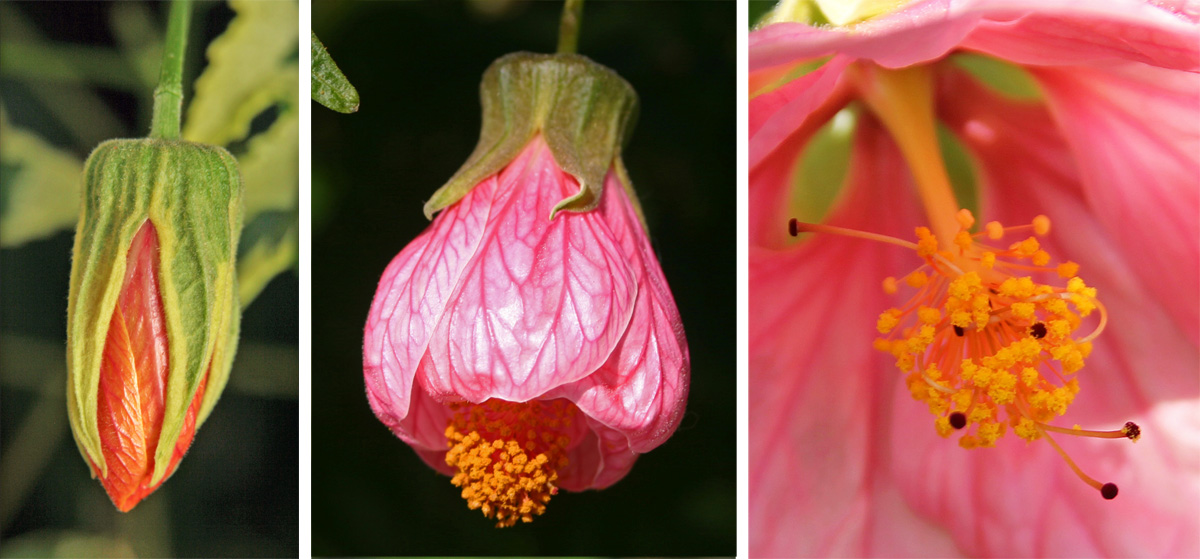 Many are attractive to butterflies and hummingbirds. Hybrids rarely set fruit, but the species produce hemispherical pods (schizocarps) with multiple segments, each containing a few seeds.
Many are attractive to butterflies and hummingbirds. Hybrids rarely set fruit, but the species produce hemispherical pods (schizocarps) with multiple segments, each containing a few seeds. 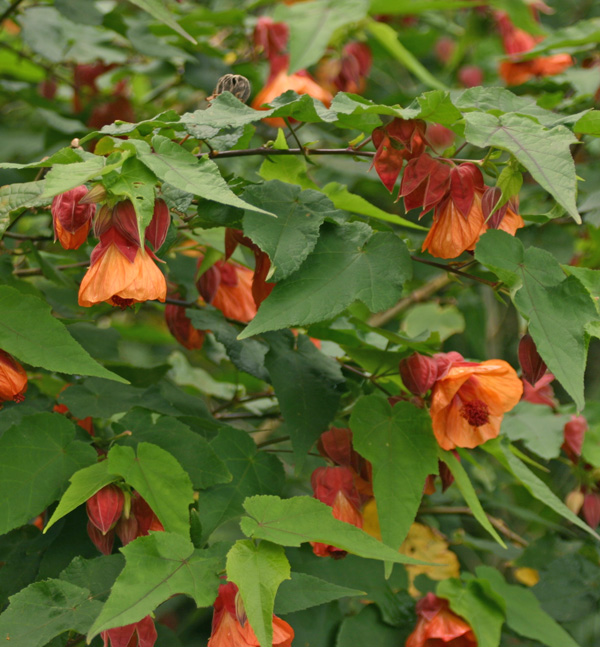 The species tend to bloom most prolifically in summer and fall, but modern hybrids have been developed to bloom nearly year-round. Flower color has been expanded by breeders as well, with flower colors ranging from white to reds, yellow, orange, coral and bicolors.
The species tend to bloom most prolifically in summer and fall, but modern hybrids have been developed to bloom nearly year-round. Flower color has been expanded by breeders as well, with flower colors ranging from white to reds, yellow, orange, coral and bicolors. 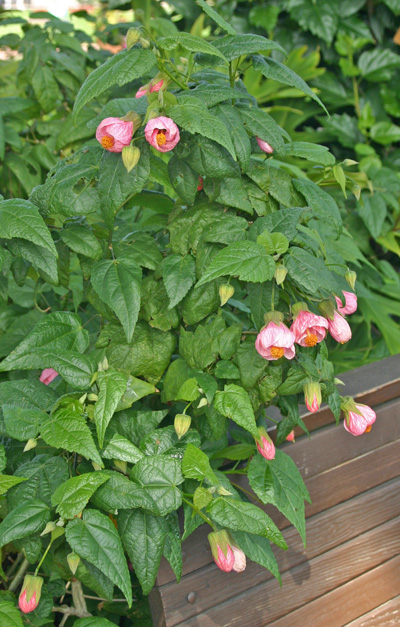 Flowering maples are a great addition to annual or mixed beds or borders, The can be used alone or with other plants in containers, such as patio pots or window boxes. They work well in hanging baskets, where it is easier to see the downward facing flowers. Flowering maple can be grown as a multi-stemmed shrub or pruned as a standard for a more tree-like effect, and many types can even be used for espalier. The variegated forms may be grown more as foliage plants than for their flowers. Grow flowering maple in full sun or partial shade. They grow in almost any type of soil as long as it is well-drained and evenly moist, doing best in rich soils. Plants will struggle if allowed to dry out too much. They typically do not have any significant insect or disease problems outdoors, but indoor plants are susceptible to the most common insect pests including aphids, mealybugs, scales and whiteflies, as well as spider mites.
Flowering maples are a great addition to annual or mixed beds or borders, The can be used alone or with other plants in containers, such as patio pots or window boxes. They work well in hanging baskets, where it is easier to see the downward facing flowers. Flowering maple can be grown as a multi-stemmed shrub or pruned as a standard for a more tree-like effect, and many types can even be used for espalier. The variegated forms may be grown more as foliage plants than for their flowers. Grow flowering maple in full sun or partial shade. They grow in almost any type of soil as long as it is well-drained and evenly moist, doing best in rich soils. Plants will struggle if allowed to dry out too much. They typically do not have any significant insect or disease problems outdoors, but indoor plants are susceptible to the most common insect pests including aphids, mealybugs, scales and whiteflies, as well as spider mites. 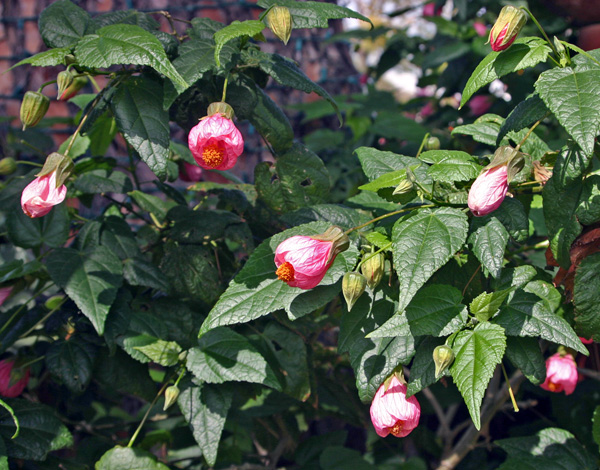 Flowering maples are easy to grow in containers and overwinter indoors. If given sufficient light, many will continue to bloom through the winter. They do best in a bright, sunny location, but prefer relatively cool temperatures (60’sF). Containers can be moved outdoors after the last frost, and should be moved back indoors before the first frost in the fall. Keep evenly moist during the growing season, but reduce watering indoors in the winter but avoid letting the plant dry out completely. Fertilize regularly starting in late winter when growth resumes, and stop in the fall. Some people recommend monthly fertilization, while others suggest every other week with half strength solution. Repot in the spring every year or two, using standard soilless potting medium. Moving to a larger pot will allow the plant to grow larger, so if space is limited just repot in the same size container.
Flowering maples are easy to grow in containers and overwinter indoors. If given sufficient light, many will continue to bloom through the winter. They do best in a bright, sunny location, but prefer relatively cool temperatures (60’sF). Containers can be moved outdoors after the last frost, and should be moved back indoors before the first frost in the fall. Keep evenly moist during the growing season, but reduce watering indoors in the winter but avoid letting the plant dry out completely. Fertilize regularly starting in late winter when growth resumes, and stop in the fall. Some people recommend monthly fertilization, while others suggest every other week with half strength solution. Repot in the spring every year or two, using standard soilless potting medium. Moving to a larger pot will allow the plant to grow larger, so if space is limited just repot in the same size container. 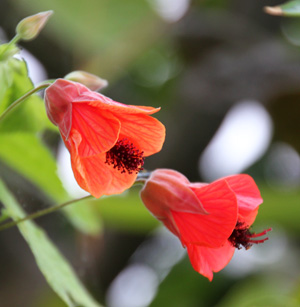 These plants have a tendency to become leggy and without regular pruning they can grow into a scraggly shrub. To maintain a dense, compact form they need to be pinched regularly. This will also promote more blooms as they only flower on new wood. Pinching, pruning and keeping a plant slightly root bound will help control its size. Major pruning should be done in early spring or late fall. Cut back branches selectively to shape the plant, making the cuts just above a node or on a strong, vigorous shoot near the plant’s base. Abutilon species can be grown from seed (it may take a full year before they begin blooming), but cultivars and hybrids are propagated by softwood cuttings taken at any time of the year. Bottom heat will speed rooting. Tip cuttings can be taken in late summer to overwinter instead of keeping the entire plant. Hundreds of varieties have been developed over the years. Some of the more commonly available abutilons include:
These plants have a tendency to become leggy and without regular pruning they can grow into a scraggly shrub. To maintain a dense, compact form they need to be pinched regularly. This will also promote more blooms as they only flower on new wood. Pinching, pruning and keeping a plant slightly root bound will help control its size. Major pruning should be done in early spring or late fall. Cut back branches selectively to shape the plant, making the cuts just above a node or on a strong, vigorous shoot near the plant’s base. Abutilon species can be grown from seed (it may take a full year before they begin blooming), but cultivars and hybrids are propagated by softwood cuttings taken at any time of the year. Bottom heat will speed rooting. Tip cuttings can be taken in late summer to overwinter instead of keeping the entire plant. Hundreds of varieties have been developed over the years. Some of the more commonly available abutilons include:
As a gardener, few things are more concerning than seeing your prized abutilon plant’s leaves start to turn yellow. After all, this colorful flowering plant, also known as flowering maple, is beloved for its ornamental value. So when those vibrant leaves begin to lose their luster, it’s understandable to worry.
The good news is with the right troubleshooting you can get your abutilon back to its former glory. In this article, we’ll look at the most common reasons for yellow leaves on abutilon plants and how to fix them.
Overwatering
Excess moisture is one of the top causes of abutilon leaves turning yellow. When overwatered, the roots are deprived of oxygen This prevents them from taking up nutrients properly, resulting in yellowing leaves.
Signs of overwatering include
- Leaves yellow first at the base or lower part of the plant
- Leaves feel soft or mushy
- Stems appear weak and limp
- Brown, mushy roots
To fix: Allow the soil to completely dry out between waterings. Gently remove the plant from its pot and inspect the roots – trim off any that are black or mushy. Repot in fresh, well-draining soil.
Underwatering
While overwatering is common, the opposite problem – underwatering – can also cause yellowing leaves. Abutilons prefer consistently moist soil. When the soil dries out too much between waterings, the plant becomes stressed.
Signs of underwatering:
- Leaves turn yellow first on tips and edges
- Leaves feel crisp or dry
- Growth is stunted
To fix: Water more frequently, but take care not to overdo it. Aim to keep the soil evenly moist but not soggy.
Nutrient Deficiencies
Lack of important nutrients like nitrogen, iron, and magnesium can cause abutilon foliage to turn yellow. This is especially common in containers where nutrients can become quickly depleted.
- Yellowing starts at leaf tips and edges
- Veins remain dark green
- Growth is stunted
To fix: Fertilize with a balanced 10-10-10 fertilizer, following label directions. For iron-specific yellowing, use a fertilizer containing iron or an iron supplement.
Sunlight Issues
Too much or too little light can stress abutilons and cause yellowing. These plants do best in bright, indirect sunlight – direct hot sunlight often scorches the leaves. On the other hand, too little light prevents the plant from photosynthesizing properly.
To fix: Move the plant to a spot with the right amount of sunlight for your specific variety. Most do best in east or west-facing windows where they get diffuse light all day.
Environmental Stress
Fluctuations in temperature or humidity can take a toll on abutilons. If the plant is exposed to drafty areas or hot, dry air from heating vents, it may respond by yellowing its leaves.
To fix: Provide as stable an environment as possible. Keep away from drafty windows and vents. Consider using a humidifier if the air is very dry.
Pest Problems
Spider mites, mealybugs, aphids and other pesky bugs can infest abutilons. They damage the leaves while feeding, causing yellow spots, streaks or distorted growth. Check carefully along the undersides of leaves and at the stem joints for signs of critters.
To fix: Hose down the plant to remove pests. For heavy infestations, use insecticidal soap or neem oil. Isolate affected plants and treat repeatedly until pests are gone.
Diseases
Fungal diseases like botrytis, powdery mildew and leaf spot can also lead to yellowing leaves. High humidity encourages these pathogens to take hold. Inspect leaves closely for spots, rust markings or white fungal growth.
To fix: Improve air circulation. Avoid wetting foliage when watering. Apply copper fungicide spray at first signs. Remove and destroy severely infected leaves/plants.
Solutions and Prevention
Caring properly for your abutilon is key to prevent future yellow leaves. Follow these tips:
-
Water thoroughly when top 1-2 inches of soil are dry. Provide good drainage.
-
Fertilize regularly in spring through summer.
-
Give bright, indirect light.
-
Watch for pests and treat early.
-
Prune any dead/dying stems to encourage new growth.
-
Bring indoors or protect from frost in winter.
With diligent monitoring and care, your abutilon should reward you with healthy green growth for years to come. The key is observing closely and taking prompt action at the first sign of problems.

Featured Articles by Season




Ask Your Gardening Question
If you’re unable to find the information you need, please submit your gardening question here:
TOP 10 REASONS FOR LEAF YELLOWING AND LEAF BURNING / BROWNING WITH TREATMENT
FAQ
Why are the leaves on my abutilon turning yellow?
How often should you water Abutilon?
How do I stop my plant leaves turning yellow?
What to fertilize abutilon with?
